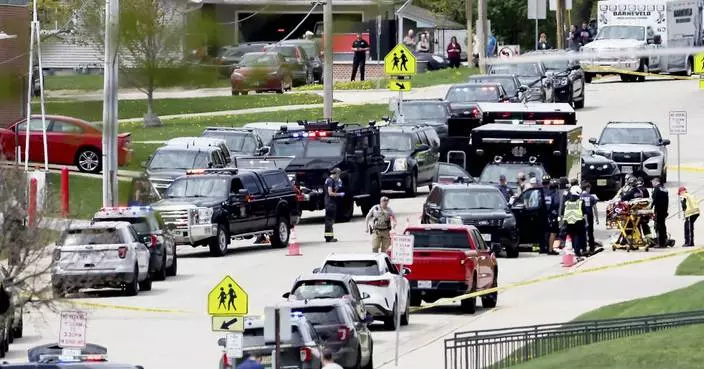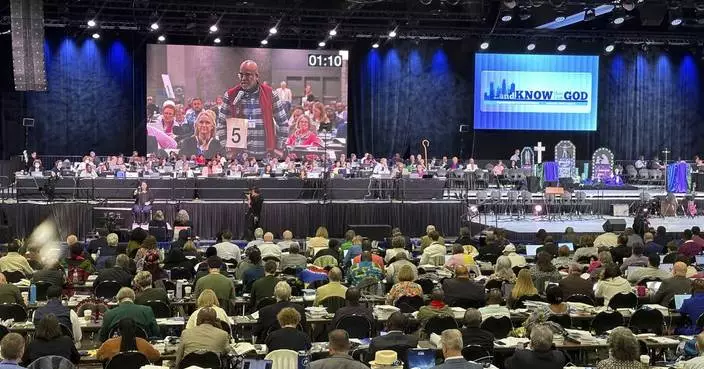BUENOS AIRES, Argentina (AP) — Argentina’s highest criminal court reported a new development Thursday in the elusive quest for justice in the deadliest attack in the country's history — the 1994 bombing of a Jewish community center headquarters — concluding Iran had planned the attack and Lebanon’s Hezbollah militant group had executed the plans.
In a ruling obtained by The Associated Press, Argentina’s Court of Cassation deemed Iran and its Lebanese proxy, Hezbollah, responsible for the bombing in Buenos Aires that leveled the community center, killing 85 people, wounding 300 and devastating Latin America's biggest Jewish community. The court said the attack came in retaliation for Argentina reneging on a nuclear cooperation deal with Tehran.
Alleging Iran’s “political and strategic” role in the bombing, the Argentine court paved the way for victims' families to bring lawsuits against the Islamic Republic. In the past three decades, Iran has not turned over citizens convicted in Argentina. Interpol red notices to law enforcement agencies around the world have led nowhere.
“The significance of these grave human rights violations for the international community as a whole invokes a state’s duty to provide judicial protection,” the ruling said, declaring the bombing of the Argentine Jewish Mutual Aid Association community center a “crime against humanity.”
The court decision came as no shock. Argentina’s judiciary has long maintained Iran was behind the attack, chilling relations between the countries — particularly after the collapse of a joint investigation. Iran has denied involvement. A spokesperson for Hezbollah, Israel’s archenemy on its northern border, did not immediately respond to a request for comment.
What some said they found shocking, rather, was the court’s failure to provide concrete evidence of Iran’s direct involvement or shed new light on the case after 30 years of setbacks and scandals.
“I would never rule Iran out, it’s certainly on the list of suspects, but let’s do something specific to rule it in,” said Joe Goldman, who co-authored a book about the winding investigations into the Jewish community center attack as well as bombing of the Israeli embassy in Buenos Aires that killed more than 20 people in 1992. “That would be a serious investigation that we haven't seen.”
The court singled out top Iranian officials and paramilitary Revolutionary Guard commanders in its determination that Iran carried out the bombings in response to Argentina scrapping three contracts that would have provided Tehran with nuclear technology in the mid-1980s. Its conclusions were based on confidential intelligence reports.
In light of the court ruling, Israel asked Argentina to declare the Revolutionary Guard a terrorist organization. Israeli Foreign Minister Israel Katz said in a statement Friday that he reached out to his counterpart in Argentina, Diana Mondino, to deliver the request. The two spoke late Thursday, Katz said.
Past inquiries into the bombings have turned up indictments, not just against Iranian officials but also two former Argentine presidents. In 2015, the chief prosecutor in the case was mysteriously found dead in his bathroom the day before he was to go public with claims that top Argentine officials had conspired with Iran to cover up responsibility for the bombing. Over the years, witnesses have been threatened and bribed.
On Thursday, the Court of Cassation reduced by two years the six-year sentence of an Argentine judge accused of paying a witness $400,000, and upheld other sentences against former prosecutors.
Thursday’s ruling comes just months ahead of the event’s 30th anniversary. Even as the case has stalled for years, Argentine authorities have timed big announcements to coincide with anniversaries of the bloody attack. When marking 25 years since the attack, Argentina designated Hezbollah a terrorist organization and froze the group’s financial assets.
Representatives from Argentina’s Jewish community, home to some 230,000 Jews, praised Thursday’s court ruling as “historic, unique in Argentina.”
“It’s politically opportune,” added Jorge Knoblovits, the president of Argentina’s umbrella Jewish organization, pointing to renewed scrutiny of Iran’s support for militant groups following Hamas’ devastating Oct. 7 attack on Israel.
But for the relatives of those killed in the bombings, the ruling was just a grim reminder of their anguish as the case remains open.
“We hope one day complete justice and truth will come,” said Memoria Activa, an association of families of victims of the attack. “And that these judges will stop profiting from our dead.”

FILE - An Argentine and Israeli flag stand side by side at the office of Guillermo Borger, president of the Jewish community center AMIA, during an interview with The Associated Press in Buenos Aires, Argentina, on Feb. 8, 2013. Argentina’s highest criminal court on Thursday, April 12, 2024, reported a new development in the elusive quest for justice in the country’s deadliest attack in history – the 1994 bombing of a Jewish community center headquarters – concluding Iran had planned the attack and Lebanon’s Hezbollah militant group had executed the plans. (AP Photo/Victor R. Caivano)
WASHINGTON (AP) — The last thing standing between Ashnaelle Bijoux and her college dream is the FAFSA form — a financial aid application that's supposed to help students go to college, but is blocking her instead. She has tried to submit it over and over. Every time, it fails to go through.
“I feel overwhelmed and stressed out,” said Bijoux, 19. She came close to tears the last time she tried the form. “I feel like I'm being held back."
Normally a time of celebration for high school seniors, this spring has been marred by the federal government's botched rollout of the new FAFSA application. By May 1, students usually know where they're headed to college in the fall. This year, most still haven't received financial aid offers. Three months before the start of fall classes, many don't know where they're going to college, or how they're going to pay for it.
“We’re asking them to make probably one of the biggest financial decisions — and decisions that will have the biggest implications on their lives going forward — without all of the information,” said Justin Draeger, president and CEO of the National Association of Student Financial Aid Administrators.
The FAFSA, or Free Application for Federal Student Aid, went through a massive overhaul that was supposed to make it simpler and shorter. But a series of blunders by the Education Department made it harder than ever, delaying college decisions by months and raising fears that hundreds of thousands of students will forgo college entirely.
Across the United States, the number of students who have successfully submitted the FAFSA is down 29% from this time last year, and it’s even worse at schools with more low-income students, according to the National College Attainment Network.
The group's CEO, Kim Cook, warned members of Congress this month about a potentially “catastrophic” drop in college enrollments that would make the decreases of the pandemic seem mild.
For Bijoux, of Norwich, Connecticut, the FAFSA problems threaten to undermine the promise of higher education.
To her, college is a chance to seize the opportunities that weren't available to her mother, who immigrated from Haiti to the U.S. as an adult. Bijoux hopes to become a therapist and set a positive example for her three younger brothers.
If her FAFSA goes through, she should be eligible for enough financial aid to help with the $ 13,000-a-year tuition at Southern Connecticut State University. If not, she might go to a local community college, but even that would require loans if she can't complete the FAFSA.
“That’s why it hurts, because it’s like you work so hard to go somewhere and do something and make something of yourself,” Bijoux said. “I thought I would start at a four-year (college) and then work hard continuously, like I’ve been doing basically my whole life. But that’s not the case.”
The updated FAFSA form has one section filled out by students and another by their parents. But when Bijoux finishes her part, nothing shows up on her mom's online account. She keeps trying, but nothing seems to change.
Similar problems have been reported across the country, along with numerous other bugs that the Education Department has scrambled to fix. Families who call for customer service have faced long wait times or say the call center hung up on them.
It “drains all the momentum” from families working to send their children to college, especially those navigating the process for the first time, said Anne Zinn, a counselor at Norwich Free Academy, where Bijoux goes to school.
“I can only say so many times, ‘Just be patient, just be patient,’ before they throw their hands up and they’re like, ‘Why am I doing this? I’m just gonna go get a job,'" she said.
The rollout has attracted bipartisan criticism in Congress, and it's being investigated at the request of Republicans. Last week, Richard Cordray, the federal student loan chief who oversaw the FAFSA update, announced he's stepping down at the end of June.
For colleges, too, the delays pose a major threat.
Enrollment decreases like those being projected now could put many small colleges out of business, or necessitate deep cuts in staff. Some colleges are pushing for emergency relief just to stay afloat, said Angel Pérez, CEO of the National Association for College Admission Counseling.
“If they don’t get checks from the federal government to basically get them through next year, they will not survive,” Pérez said.
The FAFSA has been the linchpin of student financial aid for decades. It's used to determine eligibility for the federal Pell grant, a scholarship for low-income students, and it's required to receive federal student loans. Colleges and states also use FAFSA to distribute their own scholarships.
FAFSA had long been maligned for being tedious, difficult and intimidating to families without college experience. Congress passed legislation in 2020 meant to simplify the form. The Education Department was ordered to reduce the number of questions from more than 100 to about 40, and change the formula to expand aid to more students.
Problems started piling up as soon as the new form went online in December, already months overdue.
The first applications were incorrectly processed using an outdated calculation for inflation. Later, a federal contractor miscalculated a different formula on more than 200,000 applications. Each mistake added to delays, leaving students waiting longer to hear anything about financial aid.
Even more worrisome is a misstep that blocked students from finishing the form if they have a parent without a Social Security number. Advocates say the system locked out hundreds of thousands of students who are U.S. citizens or permanent residents but whose parents are not.
The Education Department on Tuesday said it's giving those parents a new way to enter their tax information manually. But as recently as this week, some students said they were still blocked from submitting the form.
Federal education officials say they're addressing lingering bugs but making progress. More than 8 million student applications have now been processed and sent to colleges, the agency said, and new applications are being processed within three days.
Still, the wait is far from over. It usually takes weeks for schools to prepare financial aid offers. Some colleges have extended decision deadlines to give students more time to weigh their options. But some stuck to May 1, forcing students to choose a college — and make a nonrefundable payment to hold their spot — without knowing all their scholarship options.
In West Virginia, Gov. Jim Justice on Tuesday declared a state of emergency that allows students to receive state scholarships without having their FAFSA processed by the federal government. West Virginia has the lowest number of college graduates in the nation, and the state’s high school FAFSA completion rates are currently down nearly 40%, said Justice, a Republican.
"Really and truly, a lot of kids are sitting on the sidelines ... wondering, ‘Am I going to be able to go to college?’ ” he said during a news briefing.
In Baltimore, Camryn Carter is waiting to find out if he'll get a full ride to the University of Maryland or face tens of thousands of dollars in student loans.
A top student and captain of his baseball and wrestling teams, Carter sees college as a step up in life. He thinks back to the times in the grocery store line when he had to put items back on the shelf because his mom couldn't afford the bill. A college degree would give him the stability he didn't always have, the 18-year-old said.
But when he looks at tuition, it's intimidating. Along with Maryland, he's also considering McDaniel College, a private school in Maryland. If he enrolls there, he expects to borrow almost $30,000 a year.
“I try to make the best decisions now so I can have a good future,” he said. “I'm a little nervous that things won't work out. But I'm faithful.”
__
Leah Willingham contributed reporting from Charleston, West Virginia.
__
The Associated Press’ education coverage receives financial support from multiple private foundations. AP is solely responsible for all content. Find AP’s standards for working with philanthropies, a list of supporters and funded coverage areas at AP.org.

Ashnaelle Bijoux poses on campus, Saturday, April 27, 2024, at Norwich Free Academy in Norwich, Conn. Bijoux, a senior at NFA, has been unable to complete the FAFSA form due to a glitch with the form. Without the form and the financial aid it brings, Bijoux won't be able to pursue her goal of going to Southern Connecticut State University to become a therapist. (AP Photo/Jessica Hill)

Ashnaelle Bijoux poses on campus, Saturday, April 27, 2024, at Norwich Free Academy in Norwich, Conn. Bijoux, a senior at NFA, has been unable to complete the FAFSA form due to a glitch with the form. Without the form and the financial aid it brings, Bijoux won't be able to pursue her goal of going to Southern Connecticut State University to become a therapist. (AP Photo/Jessica Hill)

Ashnaelle Bijoux poses on campus, Saturday, April 27, 2024, at Norwich Free Academy in Norwich, Conn. Bijoux, a senior at NFA, has been unable to complete the FAFSA form due to a glitch with the form. Without the form and the financial aid it brings, Bijoux won't be able to pursue her goal of going to Southern Connecticut State University to become a therapist. (AP Photo/Jessica Hill)

Ashnaelle Bijoux poses on campus, Saturday, April 27, 2024, at Norwich Free Academy in Norwich, Conn. Bijoux, a senior at NFA, has been unable to complete the FAFSA form due to a glitch with the form. Without the form and the financial aid it brings, Bijoux won't be able to pursue her goal of going to Southern Connecticut State University to become a therapist. (AP Photo/Jessica Hill)














